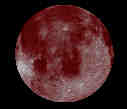 |
A partial lunar eclipse will be visible from all of Australia. The eclipse covers the period fropm 1133 to 1730 UT with the greatest extent of the eclipse occurring at 1432 UT. For more details see Eclipses@NASA. |
 |
A partial lunar eclipse will be visible from all of Australia. The eclipse covers the period fropm 1133 to 1730 UT with the greatest extent of the eclipse occurring at 1432 UT. For more details see Eclipses@NASA. |
 |
The CSIRO radio telescope at Parkes is now half a century old. Famous for its role in the Apollo program, as shown in the movie "The Dish", its prime role is in radio astronomy, where it has supported key astronomical research for Australian and overseas astronomers. A conference commemorating the facilty will be held this month at Parkes. For more details see Parkes 50th. |
 |
The United Nations General Assembly has declared this
time in October as World Space Week "To celebrate each year
at the international level the contributions of space science and
technology to the betterment of the human condition".
The theme for World Space Week 2011 is "50 Years of Human Spaceflight."
World Space Week |
 |
The 11th Australian Space Science Conference will be held at the Australian National University in Canberra. Jointly sponsored by the National Committee for Space Science and the National Space Society of Australia, it will cover the areas of space science, space engineering, space industry, government space and space education and outreach. More details can be found at ASSC-11. Details of previous conferences can be found at Australian Space Science Conference |
 |
The Australian Gemini Office in conjunction with the Australian Astronomical Observatory will hold the workshop in the ATNF Marsfield Lecture Theatre in Sydney. The workshop is designed to be an introduction to the optical and infrared facilities available to the Australian astronomical community, and will include tutorials and demonstrations where you can get your hands on real data and learn how to reduce it. For more details see AUSGO/AAO workshop. |
 |
The 11th Australian Mars Exploration Conference will be held in Perth at the University of Western Australia. The theme this year will be "Environments for the Dawn of Life on Mars and Earth". More details can be found at AMEC 2011. |
  |
The Mars Society Australia offers Science teachers and graduate students an opportunity to join with NASA and MSA scientists on a field expedition to the Pilbara. It will involve participants examining fossil sites recording the early emergence of life of Earth, and also areas of tourist interest for the "Dawn Of Life Trail" near Marble Bar. More details can be found at SBA. |
 |
The inaugural Australian Astroimaging Conference will be held in the Crowne Plaza Hotel in Surfers Paradise, Queensland. For more details see AAIC2011. |
 |
The 2011 Annual Scientific Meeting and General Meeting of the Astronomical Society of Australia will be held at the University of Adelaide in South Australia. For more details see ASAM2011. |
 |
The International Union of Geodesy and Geophysics will hold its 25th conference in Melbourne, Victoria. This large meeting will host many oral and poster presentations with a space related theme. The theme of the conference is "Earth on the Edge: Science for a Sustainable Planet". For more details see IUGG2011. |
 |
This eclipse starts at 1724 and ends at 2300 UT, with the greatest extent occurring around 2013 UT. Australians on the east coast will see only the first part of the eclipse as the latter portion occurs during daylight hours. Western Australia is best placed to observe this event. For more details see Eclipses@NASA. |
 |
On this day in 1961 the Soviet cosmonaut Yuri Gagarin became the first human to orbit the Earth. The flight in the Vostok 1 spacecraft lasted 108 minutes. |
 |
The University of South Australia will host a summer space program for the International Space University. More details can be found at UNISA and ISU. Unfortunately the school cost of $9900 will preclude attendance by many interested people. |